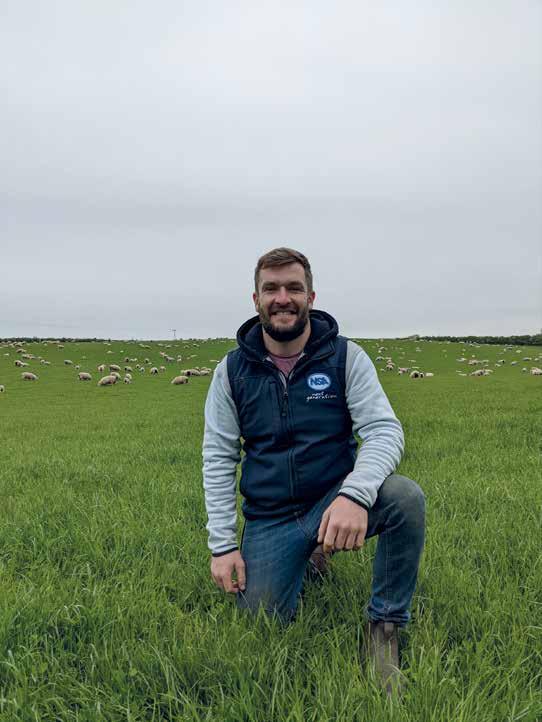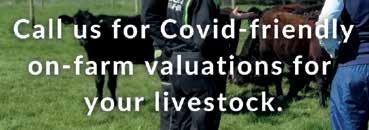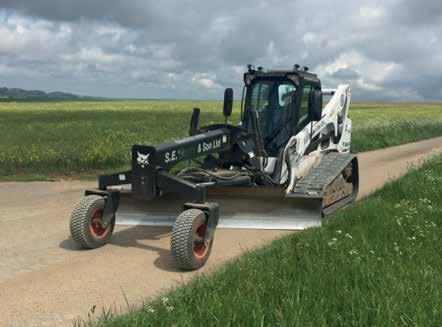
8 minute read
Sheep
Plans to tackle dog attacks on livestock ‘could go further’
Police plans to seize dogs which attack livestock should go further, say livestock leaders.
Stricter measures to crack down on sheep worrying were confirmed by the government last month. The new proposals will come into effect once the Kept Animals Bill has passed through parliament.
The National Sheep Associatio said it welcomed the strengthened legislation. But it said the additional police powers to seize dogs should have been further backed up by a big increase in the maximum fines imposed.
NSA chief executive Phil Stocker said: “This was an opportunity to create a major deterrent to this antisocial behaviour by substantially increasing the maximum applicable fine alongside more proactive measures to prevent attacks occurring.”
Mr Stocker said Defra and other government ministers responsible for English legislation were “missing a trick” by failing to take the opportunity to increase fines in line with those imposed in Scotland.
Legislation which received royal asset earlier this year mean people who fail to keep close control of their dogs in Scotland face a year-long jail sentence, a fine of up to £40,000 – or possibly both.
But a person who commits a similar offence in England under the new animal welfare legislation is liable only to a summary conviction and a fine not exceeding Level 3 on the standard scale – currently £1000.
Mr Stocker said the English bill was welcome but contained little that would reduce the number of dog attacks. “In fact, the lack of clarity in defining ‘under close control’ puts farmers and dog owners in a difficult, potentially conflicting position.”
Recent reports of out-of-control dogs causing harm to livestock including a cow being chased over an embankment to its death; and an MP being fined for his dog chasing deer in Richmond Park, London.
The rising number of incidents had come with increased dog ownership and
More dog owners are walking in the countryside
This was an opportunity for a major deterrent
more people using farmland for leisure, said Mr Stocker. The NSA’s own survey also revealed a concerning increase in dog attacks on sheep over the past year.
These incidents all pointed to an urgent need for simple, straightforward an effective measures to radically reduce the number of cases, said Mr Stocker. It should be a legal requirement for non-working dogs to be on a lead near livestock.
Defra’s proposed legislation includes plans for a maximum five-year prison sentence and unlimited fines for animal cruelty. Mr Stocker said he looked forward to working with Defra to improve responsible dog ownership.
The injury and stress involved when sheep and other livestock were attacked resulted in serious animal cruelty and should therefore be subject to similar maximum penalties and deterrents, he added.
While the NSA would like to see legislation strengthened beyond what appears to be proposed it will also continue to campaign to improve attitudes to responsible dog ownership, to protect its members’ livelihoods and reduce stress and anxiety.
Traumatic incidents ‘on the rise’
More than two thirds of the UK’s sheep farmers responding to a recent survey have experienced an increase in sheep worrying attacks by dogs during the past year.
The troubling statistic is part of a concerning set of findings released by the National Sheep Association (NSA) from its recent farmer’s survey assessing the incidence and impact of sheep worrying by dog attacks.
The NSA received a record-breaking response for its 2021 survey specifically aimed at farmers who had experienced dog attacks in the past year. The increase in contributions indicates the scale of the serious problem.
On average, each respondent to the survey experienced seven cases of sheep worrying during the past year. Each attack typically resulted in five sheep being injured and two sheep killed.
Estimated financial losses through incidents of sheep worrying of up to £50,000 were recorded, with an average across all respondents of £1570. But most respondents received no or very little compensation.
But in addition to the threat to animal welfare and the farmer’s income perhaps the most concerning finding to be taken from the survey is the effect the issue is having on the mental wellbeing of sheep farmers.
Farmers completing the survey reported feelings of anxiety, anger, upset, stress and frustration as a result of sheep worrying by dog attacks with more than half recognising that this was causing a moderate to severe impact on their mental health.
Forage crops help optimise output
• Grassland and arable cover crops • Close focus on forage management • Soil health and fertility maintained

ANottinghamshire sheep producer believes the future of his enterprise is about optimising output from an integrated mix of grassland and arable cover crops in a sustainable, regenerative system.
Fred Love, who farms at Retford, says meticulous forage management combined with Innovis genetics are enabling lambs from his 1300-ewe fl ock to take 170-200 days to fi nish with a target weight of 19-20kg and grade R3L or better.
The entire lamb crop is fi nished off forage within nine months and by the end of year – but the fl ock still manages to scan 170%, with a reared lambing percentage of 147% and output standing at 250kg/ha.
Maximum forage
“It’s all about maximising forage – both grazed grass and fodder crops, which are not only the cheapest form of feed, but also maintaining soil health and fertility,” says Mr Love, a fi rst generation farmer.
“There’s a lot being talked about regenerative farming, however that’s what I’m already working on; I fi rmly believe that sheep and arable – two specialist complementary enterprises working together are for real for the future.”
At fi rst, Mr Love stocked traditional Mule ewes at 10 ewes/ha, reaching a mature weight of almost 80kgs. But since swapping for lighter Innovis genetics – Aberfi eld crosses and Highlander maturing at 65-70kg, he has increased to 13.5 ewes/ha on heavy clay.
“Nowadays I’m able to lamb these hardy ewes outdoors,” says Mr Love. “I check two or three time a day, as few as 5% require any form of intervention and 90% lamb within the fi rst three weeks.
Perfect fit
“I’m farming sheep that look after themselves. Up to 50% of lambs are fi nished off rotational grazing within fi ve months, whilst the remainder are transferred to forage crops grown on neighbouring units.
Cover crops work out 30-40% cheaper in dry matter terms compared with silage, and ewes remain on these forage crops until March. The surrounding land is a mixture of arable and midtier Countryside Stewardship.
“The sheep fi t perfectly,” says Mr Love.
“There’s also the bonus of being able to run one ram to 100 ewes, and I’m ex-
Maximising forage has achieved good results, says Fred Love




To find us, search: Meadow Quality




01789 734100
What is regenerative agriculture?
Regenerative agriculture is a system of principles and practices that seeks to restore and enhance the farm’s entire ecosystem – with a focus on soil health.
Advocates aim to improve the resources the use, rather than destroying or depleting them. Mixed farming is often seen as the way to achieve this – and introducing systems such as rotational grazing and cover crops improve soil structure and health.
In turn, these approaches result in higher quality yields and a richer, more natural environment without the need for purchased inputs such as concentrate feed and artifi cial fertilisers, together with reduced pesticides and herbicides.
Furthermore, sheep have a minimal carbon footprint, says Dewi Jones, chief executive of sheep breeding specialists Innovis. Carbon neutrality is as a real option for many producers who sequester woody vegetation to offset on-farm emissions, he adds.
This can be done sensibly while adding value to the farm infrastructure and its ecosystem, and producing high quality, nutrientdense food. And while output is often reduced, there is frequently a healthier bottom line.
“There are many unanswered questions and a whole raft of research work needed before we fully understand the regenerative agriculture approaches we are being encouraged to use,” says Mr Jones.
“But I suggest we best start making progress since our antipodean counterparts are forging already ahead on this path. It’s about mall, measured steps.”

pecting my rams to last fi ve working years. I think I’ve established a good template for continuing to grow the business and I’m currently targeting a minimum 2,000 ewes.
“I am no expert on regenerative farming systems but I’m learning quickly.”
Fred Love, Retford, Notts

Grassland: 60ha owner occupied; 80ha rented Cover crops: 160ha, 70% grown on contract 900 Aberfi eld x Lleyn ewes 200 Highlander ewes 100 Romney x Aberfi eld ewe lambs 100 Aberfi eld x ewe lambs



01527 893343 www.sedavis.co.uk



